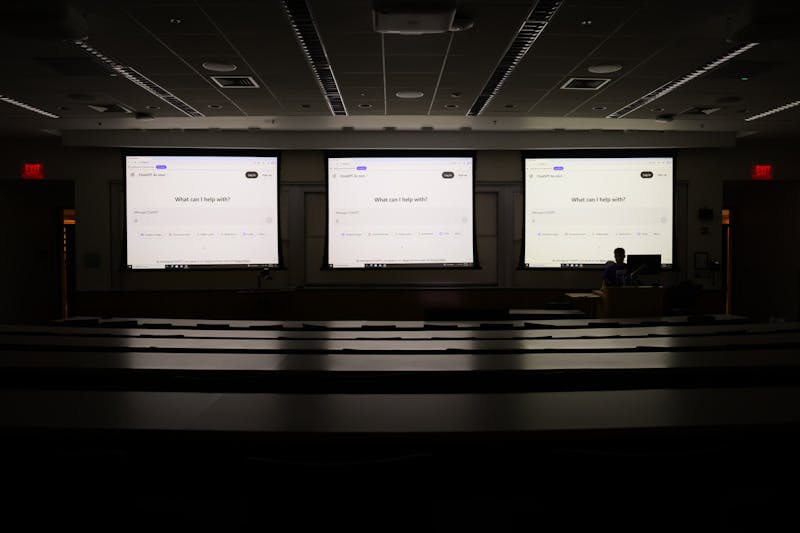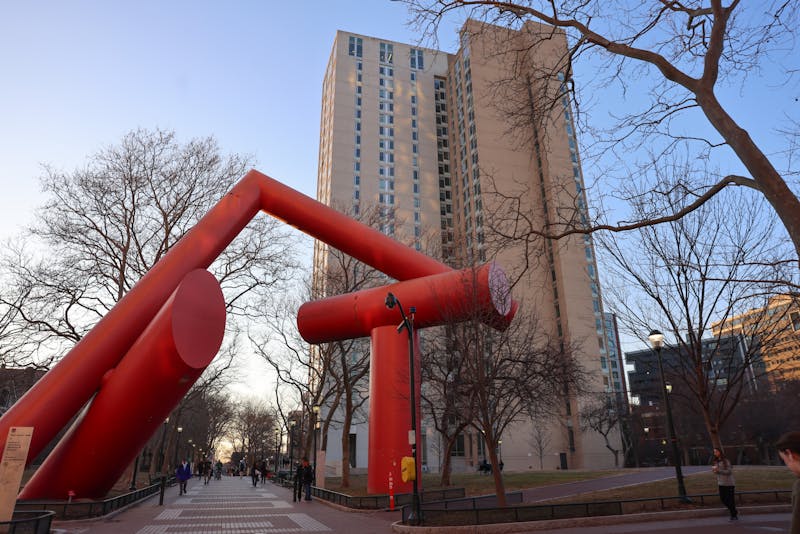The school year was over, and it was just about time for summer. In a show of class unity, students marched proudly in a grand procession, fulfilling one of Penn's most recognizable traditions.
As they marched, though, members from a rival class pelted them with rotten eggs and other rubbish. The bombardment wasn't taken lightly, and fighting between the pelters and the peltees soon broke out.
Sound like Hey Day gone bad? It's not. This is a scene from Sophomore Cremation, a quasi-cultish ceremony that started on campus in 1877. Cremation remained popular for several years, but came to an explosive end in 1930 when it combined with another of Penn's more violent traditions -- the Rowbottom -- to set off one of the biggest riots in campus history.
While the beloved current traditions of Spring Fling and Hey Day have drawn increasing criticism for their drunken excess, the annual carnival in the Quadrangle and the Junior Class's procession through campus seem tame in comparison to some of Penn's traditions from years past.
This was never more apparent than when Cremation and Rowbottom collided on April 30, 1930, to create what Director of the University Archives Mark Lloyd called "a watershed moment in student-tradition history."
The Cremation
This morbid tradition got its start when Thomas Aquinas Edwards, Class of 1879, concocted the idea of burning the sophomore class's most hated textbooks and disliked syllabi; it wasn't long before effigies of professors were added to the pyre.
Annually, sophomores would don mournful black robes and mortarboards and meet off campus in the dark of night. With the school band playing funeral dirges in the background, the sophomores would make their way back to campus, all the while singing hymns and grieving over the mock coffins they carried.
Meanwhile, freshmen lined the route, angling for a showdown with their older rivals. According to George Thomas, an adjunct professor of design and co-author of Building America's First University, a history of Penn, the old traditions were designed to "give each class its own strong internal identity."
The freshmen and sophomores clashed particularly often. The Sophomore Class Record for 1879 recalls one such encounter during Cremation.
The record, admittedly biased to the sophomores, says that when a first-year student tried to break into the procession, "the rude hand of a riotous sophomore [arrested] his innocent desire."
Once back on campus, the sophomores -- armed with hymn books, programs and a funeral pyre -- began the ritualized ceremony.
The 1893 ceremony -- the first one in which a professor's likeness was roasted -- likely opened with the reading of the condemnation of the doomed Chemistry professor Walter Keith printed on the first page of the program (or some rough portraying the same sentiment, anyway):
"We wish to announce to our friends that the fiend whom we shall endeavor to reduce to ashes by means of our Mongolia Crematory, is
(1) a very foul fiend indeed,
(2) a left-handed, extravagant monstrosity of a genus monkey,
(3) of an unusual name, formed by the change of dental t to k and adding of 'eeth' = K2Much4Us
REQUIESCAT IN HADES."
The celebration continued with a requiem, as well as speeches, poems and hymns castigating the professors, all set to the tunes of the most popular songs of the day.
The Pennsylvanian, a precursor to the DP, gleefully reported the burning of Keith's effigy:
"After the head of the victim had been chopped off and swung in the air, the pyre was lighted and the body burned amid the firing of rockets and fire crackers and the howling and dancing of the torturers."
Cremation continued with only a few gaps until 1925, when the Undergraduate Council banned it, citing an excess of violent conflict between the freshman and sophomore classes. The mock funeral would lay dormant for only five years, though, until its resurrection in April, 1930.
The Rowbottom
The word "Rowbottom" became synonymous with rioting at Penn starting in 1910.
Nobody is quite sure of the exact origins of the Rowbottom -- some have said that Joseph T. Rowbottom's friends would call out his name to mock him for always being holed up in his room in the Quad, doing work. Others have said it was simply Rowbottom's friends calling out his name to see if he was in his room.
Still another theory -- this one posited by Rowbottom's family -- that the yell of "Yea, Rowbottom!" had its origins in a classmate yelling out from across the Quad for Rowbottom to provide him answers for homework.
However the yell started, one thing is certain: it led to chaos. Apparently fed up with the Rowbottom yell, other Quad dwellers would call for the yeller to shut up. Eventually, this progressed to throwing basins, pitchers and other projectiles out of Quad windows.
The relatively harmless defenestration shortly morphed into full-scale rioting, with hundreds, sometimes thousands, of students participating. Flooding into the streets -- particularly along Woodland Avenue, which until the 1950s ran diagonally through campus along the slanted edge of the Quad -- students would halt traffic, ignite bonfires, overturn cars, derail trolleys and do nearly everything imaginable to cause as much destruction as possible.
Unlike the Cremation, which always occurred on a set date, the annual Rowbottom could break out at any time and during any event. All it took was a large gathering of people and an excuse for somebody to let out the famous shout, "Yea, Rowbottom!"
Sports events were the most common impetus for the Rowbottom. But in 1910, student disappointment in the spectacle of Haley's Comet sparked one; in 1928, it was a power failure on campus; in 1945 V-J Day caused the students of Pennsylvania to turn their fighting spirit from the Japanese to the streets of Philadelphia; and, in 1950, a police raid on Smokey Joe's tavern set off the student masses.
But it was the Rowbottom of 1930 that caused tumult of unprecedented proportions.
April 30, 1930
It was Wednesday night, and the 53 year-old tradition of Cremation was being revived, this time by the senior class. Having obtained the proper permission from University administrators, the students went on to burn their two most hated professors in effigy near the Quad.
Tensions between police and students had been running high, though. Two days earlier, a police officer fired his gun at a group of students who were trying to free an arrested friend, missing all of them. The next day, the University was what Provost Josiah Penniman described as an "armed camp," but no conflict between police and students occurred.
It was in this context, then, that an overexcited police officer phoned in a riot call at the conclusion of the cremation ceremony, even though by most accounts it went off peacefully.
As officers began to arrive on campus en masse, the fateful call of "Rowbottom!" went up, and full-scale rioting broke out.
The police jumped into the crowd with billy clubs swinging and, according to Penniman, they arrested students "indiscriminately."
Students were not shy about retaliating. The Philadelphia Inquirer reported that "stalwart police minions found themselves bombarded with eggs -- strictly fresh and not so fresh -- produce from the local marts, hunks of this and that, and bags, well filled with aqua pura."
The chaos escalated through the night, with students diving into local shops for cover and police diving in after them. Despite the onset of the Great Depression, rioters and cops smashed up the stores, wantonly destroying property. The Inquirer reported that, by night's end, a drugstore on the corner of 37th and Spruce streets looked "as if a herd of wild bulls had held carnival in it."
Numerous fraternity houses were also broken into and raided. To get into the Delta Tau Delta house, police shot the locks off the back door. Officers climbed through second-floor windows of Delta Upsilon, even firing a shot through one window, according to Penniman. Once inside, the officers did plenty of damage, smashing up the houses and beating students.
By night's end, at least 300 students had been arrested, and the Penn campus looked like a war zone. About half of the students were released within a day when the University vouched for them, but relations between the police and the University did not heal so fast.
The University announced its plans to pursue prosecution of the police, and Penniman delivered an address to the student body condemning the officers.
Philadelphia Director of Public Safety Lemuel Schofield was even briefly arrested and detained in the coming days for his poor oversight of the police's recklessness. A judge quickly gave Schofield reprieve, but the situation thoroughly embarrassed Philadelphia.
Penniman's speech also admonished the students for their role in escalating the riot. From that point, he began working hard to put a final end to the Rowbottom.
According to Lloyd, the result of his work was that the Rowbottom was "banned, but not abandoned."
Though he suspects "that riotous student behavior was suppressed for a number of years" after the 1930 melee, Lloyd said that Rowbottoms did not end for good until the 1970s.
Cremation, however, appeared to have gone entirely up in flames.
So how has Penn moved from the riotous traditions of the past to the relatively sedate ones of the present?
According to Thomas, the primary reason is that, over time, tragedies have caused all of the more violent traditions to flicker out.
As time has progressed, students have also shifted their allegiance from their classes specifically to the University at large, cutting down on violent clashes, he said.
Undergraduates are also "much more serious" now, Thomas said, whereas students in the first half of the 20th century came to Penn "basically as an interlude between high school and life."
As for the ever-threatened Spring Fling and Hey Day, both Lloyd and Thomas think they should and will go on more or less unchanged.
"They've become totally institutionalized and largely internalized," Thomas said, adding that they are key components of undergraduate morale.
"They're part of why people know Penn exists," he said.
For the traditions to live on, though, students will have to be on their best behavior to impress administrators.
Hey Day is in three days. Nobody better yell, "Rowbottom."
The Daily Pennsylvanian is an independent, student-run newspaper. Please consider making a donation to support the coverage that shapes the University. Your generosity ensures a future of strong journalism at Penn.
DonatePlease note All comments are eligible for publication in The Daily Pennsylvanian.







